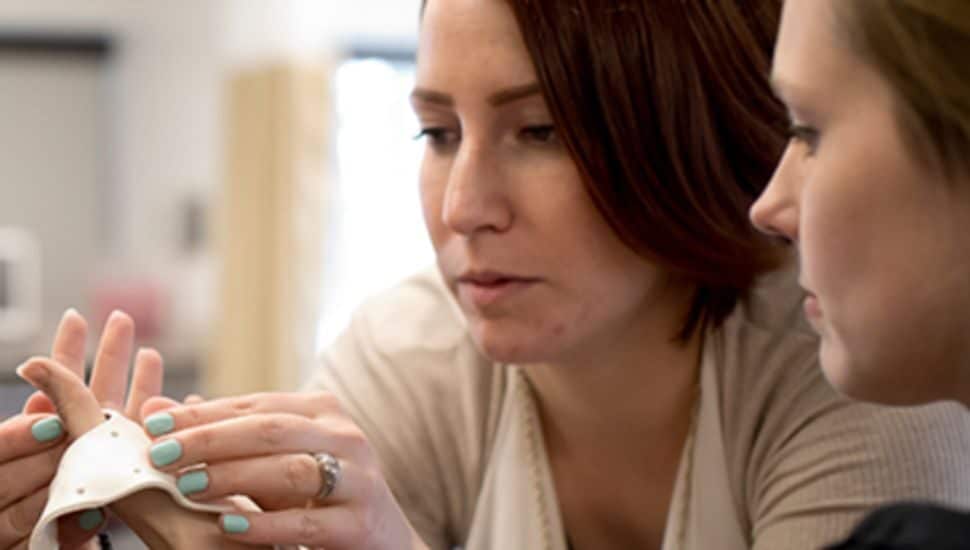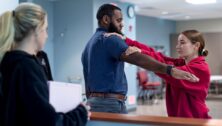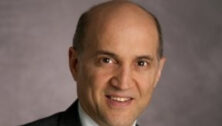Salus Professor Finds Gratifying Occupation in Training Occupational Therapists

Dr. Lauren Sponseller, Chair of the Salus University Occupational Therapy (OT) department, didn’t start wanting to instruct others on retraining patient abilities to perform various tasks.
But she did know she wanted to help people.
Initially, she considered nursing. Or teaching.
But an early encounter with a physical-therapy practitioner — and yes, there is a difference — opened her up to the possibility of taking on OT as a profession.
OT vs. PT
The all-encompassing nature of an OT career caught her attention, especially as compared with a physical therapy (PT) career.
“OT focuses on the activities of daily living,” she explained. “So that’s just about every single thing a person does in his or her daily life.
“OT looks at what that person loves to do, analyzes it, breaks it down, and finds a way to get him or her back to doing it as independently as possible.”
There’s an innovative aspect to the work, Sponseller said. It often requires a dose of creativity to accompany the physiological mechanics of activities like bathing, grooming, dressing, cooking, and cleaning.
Physical therapy, she explained, is differently focused.
“An example I give students,” Sponseller says, “is that a physical therapist will enable a patient to walk to the bathroom. And we take over from there with what happens next.”
The Component Parts
For students to gain an appreciation of the component parts of general activity, it’s necessary to first dissect them.
Sponseller remembers learning how in her own OT training.
She had the assignment to break down the making of a peanut-butter-and-jelly sandwich, a task she initially thought was simple.
But in digging into its details, she found she was wrong.

“There was maneuvering to the kitchen,” she explained. “And maintaining balance at the counter, and the strength needed to open the jars, and the fine motor skills to manipulate the knife.”
Training, Strengthening, Reassembling
It may, for example, help a post-op knee replacement recipient rebuild strength and steadiness on the new joint. But the task of training that patient to then resume gardening or using the clutch on a standard-shift car crosses into OT.
Once deconstructed, those small tasks can be trained, strengthened, reassembled, and used to bring patient capabilities forward.
And no activity a patient wants to embrace is out of the profession’s purview.
“I had client who wanted to return to poker playing,” Sponseller said. “Not as a professional. Just as a hobby.
“We then thought through all the physical tasks of playing poker — sitting at a table, holding cards, manipulating chips — and retaught all of that.”
Therapeutic Use of Self
There are, however, points in OT patient recoveries where a plateau arises.
Accepting the reality that further improvement may be out of scope, Sponseller said, is not a failure; rather, it’s viewed as advancing the patient to the point of operating as independently as possible.
This assessment often comes with OT/PT collaborations that rely heavily on input from families.
“The ‘therapeutic use of self,’” Sponseller explained,” is a concept we use.
An OT session concentrates on activity, defined broadly as the little movements that collect into an overall goal.
“We define it this way: We say to the patient, ‘This [level of recovered functionality] might not be the goal you set. But it’s where you’re at. And it’s more independent from where you were.’
“We want people to feel productive,” she continued. “So, we may settle on an adaptation — say, a shirt with buttons that invisibly close by Velcro behind them for a patient who hasn’t recovered the dexterity for traditional buttons. And that enables them to take care of themselves and present a professional look at work.
“And we celebrate that use of self.
“Also, there’s nothing to say that that adaptation has to be permanent. We tell patients, ‘This doesn’t have to be forever. As you’re gaining strength and progressing, it’s a step toward being as independent as possible.”
Changes and Perceptions
Sponseller has seen a lot of change in the industry and the educational regiment that produces its professionals.
“I’ve been at the university for more than 10 years, and I’m chair of the Salus department,” Sponseller related. “I am its inaugural faculty member — at one point, it was just me. I co-developed the curriculum and have been here since the very first class.”
She wound up at Salus on the recommendation of a colleague. She arrived somewhat familiar with the university from its proximity to her Huntingdon Valley home.
“I drove by it a lot,” she laughed.
The practice of OT has evolved greatly since then.
“It’s expanded from community practice to telehealth,” she cited as a main then-vs-now difference. “We found a way to provide treatment through the computer screen, which was on our radar for a while, but the pandemic advanced by necessity.”
She’s also noticed the profession’s public image evolving in how it is seen by both the public and those in the healthcare insurance industry.
Its perception is evolving from one whose service providers merely help elderly patients return to hobbies to ones who restore necessary functionality across multiple ages.
An OT practitioner today might just as well help a dentist regain the ability to regain the dexterity needed to provide oral care as bring a sixth grader back to her Little-League short-stop position.
A Lifetime Calling
Sponseller is so ingrained in her profession that it’s not something she can easily put aside.
It’s not that she brings work home with her, to the detriment of her family.
It’s more the case that when she sees an opportunity to be helpful outside her working hours, she assists.
“My [sons] go to a small, Catholic school in the area,” she related.
“And among their classmates, shoe-tying is a big ‘occupation’ for them, with a big learning curve.
“So I’m going to start a shoe-tying group to train the activity,” she said.
Additional Information
The OT programs Sponseller established and continues to guide in Elkins Park are described in greater detail on the Salus University website.
_____
Salus University OT student Hanna Rushkowski describes the occupational therapy program in which she is currently enrolled.
Stay Connected, Stay Informed
Subscribe for great stories in your community!
"*" indicates required fields



![ForAll_Digital-Ad_Dan_1940x300[59]](https://montco.today/wp-content/uploads/sites/2/2022/06/ForAll_Digital-Ad_Dan_1940x30059.jpg)





















![95000-1023_ACJ_BannerAd[1]](https://montco.today/wp-content/uploads/sites/2/2023/03/95000-1023_ACJ_BannerAd1.jpg)

















